How to develop security alert levels
Take an ‘all hazards’ approach to developing alert levels. That means including all types of threats from all sources, so you can generate a balanced response. Physical and environmental threats may have the same, or greater, impact on your organisation’s ability to function as traditional security threats.
Any protective security measures you implement with your alert levels should mitigate the risks to your people, information, and assets. They should also make any information and asset sharing arrangements you have more secure.
Work out your sources of physical risks
Base your alert levels on possible sources of risk to your security — risks you’ve identified in your organisation’s security risk assessment.
Sources of physical security risks fall into three main categories:
- Event – an important happening or incident that affects your organisation’s ability to function. Examples include a weather event such as a storm or an emergency event, such as an earthquake.
- Threat – a declared intent and capability to inflict harm on your people, information or property.
- Activity – an action by one or more people likely to have a negative impact on physical security. For example, protest activity, occupation or attempted occupation, or filming near your premises.
If your protective security measures are damaged or breached by an event or activity, or you have reliable evidence to support the possibility of a threat, then you may need to escalate the alert level.
Assess the unique risks of each facility or work area
Each facility or work area within a facility may have unique security risks. To identify and assess the physical security risks likely to affect each site during events, threats, or activities, your security management people should work with:
- local managers responsible for each facility
- people involved with business continuity, disaster recovery, and risk management.
Draw on internal and external sources of information
Seek information on risks from internal and external sources.
Internal sources
Your organisation’s overall risk assessment is an excellent source of information. Check the assessment and consult with your business areas to learn more.
Your business areas should be able to tell you about:
- the business impact of disruptions to their operations, harm to their people, or the compromise or loss of information or assets
- when Business Impact Levels (BILs) may change due to changes in an asset’s importance (for example at the end of a project).
Other important internal sources of information about risks are your:
- protective security risk reviews
- security incident and staff reports
- security and operational risk registers.
External sources
External sources include any organisations you work, partner, or co locate with. You should consider the BILs of any collaborative work or sharing arrangements. Do the other agencies have unique risk factors and how might they affect your combined business continuity plans?
Other examples of external sources of information you can draw on are:
Take care not to under- or over-protect
When you’re designing or selecting alert levels, aim for a balanced approach as over- or under-protecting your people, information, and assets can create problems.
Over-protection
Over-protection is costly, inefficient, and can be an obstacle to your operations. Over-protection is often caused by:
- personal interpretation of the level of harm possible from a risk source
- not having enough alert levels to allow staged escalation of measures appropriate to the increase in risk.
Under-protection
Under-protection can affect personal safety, and the security of your information and assets.
To prevent under-protection, provide guidance that makes it easy for your people to identify which risk sources require an increase in alert level. And make that increase easy to implement.
Decide how many alert levels you need
The number of alert levels to use depends on your operating environment and expected changes in your risk sources. Essential factors to consider are the nature of your organisation, the types of facilities you use, your operational role, and known risk levels.
Examples of alert levels
The following four examples of alert levels show how you can:
- define an alert level
- describe the situations each level covers
- summarise the measures that apply to each level.
Low
This security alert level applies when there is little likelihood of an event causing harm. The security measures in place would meet normal internal operational requirements.
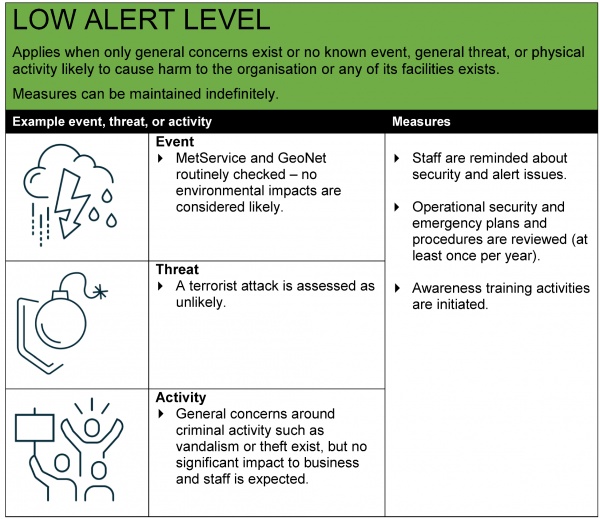
Medium
This security alert level applies when an event, general threat, or physical activity likely to cause harm might occur. However, there is no specific threat directed to your organisation or facilities.
Any security measures you apply can be maintained indefinitely, with minimal impact to your organisation’s operations.
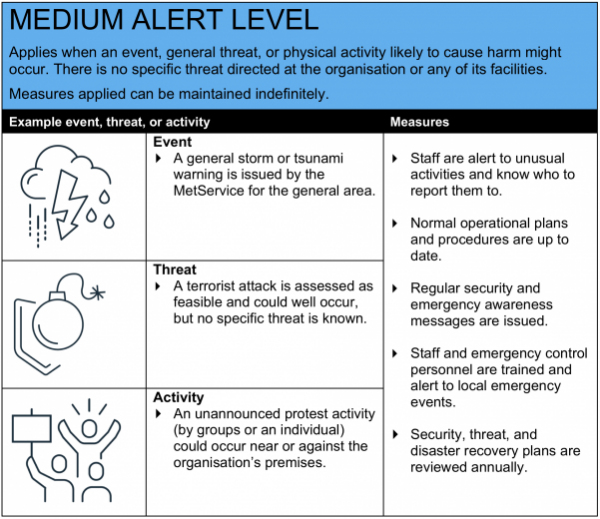
High
This security alert level applies when an event, threat, or physical activity likely to cause harm is expected to occur to your organisation or any of your facilities.
Any security measures you apply can be maintained for lengthy periods without causing undue hardship to your people, affecting operational capability, or aggravating relationships with the local community.
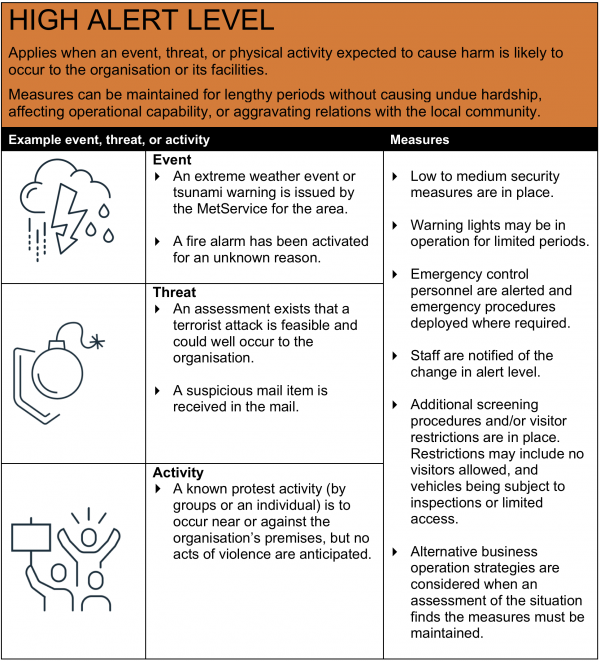
Extreme
This security alert level applies when an event, threat, or physical activity likely to cause significant harm is imminent or has occurred to your organisation or any of your facilities.
You won’t be able to maintain the necessary security measures for lengthy periods and they may cause hardship to your people, affect operational capability, or aggravate relationships with the local community.
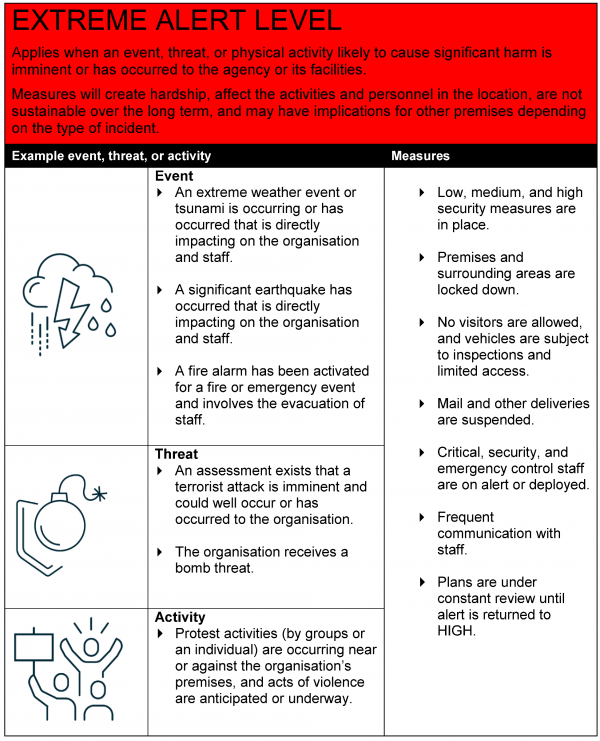
Work out and confirm your security measures
Use your assessment of risk sources and operational requirements for each facility to work out which security measures you need for each alert level.
Several generic measures might be suitable at each alert level. For examples, see Operational security measures for alert levels [PDF, 44 KB].
Your security management people should work with local area managers and consult with your risk managers to develop procedures for each facility and risk source.
Monitor your risk environment and change when necessary
You should actively monitor your organisation’s risk environment and change (increase or decrease) the alert level to match any changes to the risks.
Develop a guide to your security alert levels
Developing a guide will help you refine your alert levels and associated security measures. It’s important to consult the different business areas in your organisation. Aim to find out if your guide will be effective or have implications for other security processes within your organisation.
Once your guide is developed, it will be a vital source of information about your security alert levels.
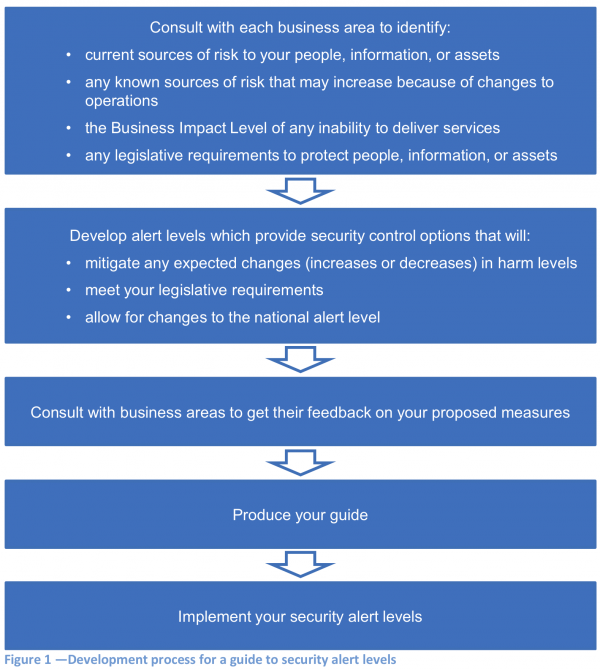
Develop a communications plan
Communicating a change in alert level well is essential to getting the right responses. Your people need to know what has changed and what to do.
Your communications plan will help you create a successful strategy. You need to consider the audiences, messages, methods, and responsibilities.
Audiences: Who needs to know about the alert and what do they need to know? Different communication may be required for different audiences (senior management, staff, security staff).
Messages: Which messages do you need to communicate to each audience? Aim to create concise and unambiguous statements that clearly identify the issues and the actions required.
Methods: How will you communicate the messages? Choose the best medium or combination of mediums to get your messages to your audiences as quickly and effectively as possible.
Responsibilities: Your strategy should clearly identify:
- who is responsible for determining the alert level (this may differ for each level and facility)
- any specific roles or responsibilities for other positions, as well as all staff.
Ask your communications team for expert advice when you’re developing the communications plan.
Related guidance
HB167:2006 Security risk management
This handbook suggests using the IRACI tool (Intervention, Responsibility, Accountability, Consult and Inform) to work out who needs to be involved in developing the strategy.
Review and update your processes
You should review your alert level processes:
- when you take on new projects
- as the risk environment changes
- after a significant incident that affects your ability to operate
- at least every 2 years.
Practise and review the activation procedures for your alert levels as well as the security measures for each level. Use what you learn to identify any gaps and update your guide.
Debrief after going to high or extreme alert levels
A debrief can be helpful for improving your response. Consider debriefing after every alert level change to ‘high’ or ‘extreme’. A debrief should consider:
- why the alert level change was initiated
- how the alert level change was initiated
- what activity and actions were undertaken for the alert level change
what and where, if any, improvements could be made to alert level procedures and communications.




